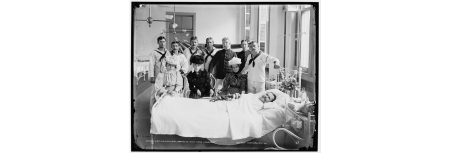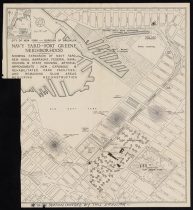
“The New York Naval Yard”
One of New York’s most terrifying historical contributions during the Revolutionary War were the British prison ships located off Wallabout Bay in what today is Brooklyn[1]. The horrors of the ships included rampant disease, beatings, and gross mistreatment and neglect of American patriots, including the HMS Jersey, which is said to be responsible for the deaths of 12,000 Americans[2]. The selection of the docks in which these ships were located however, would be the birthplace of America’s naval strength and prestige that would surpass that of the British, and serve America for the next 160 years. Located on the Western End of Long Island in Wallabocht Bay, now known as Wallabout Bay. The bay is named after the Dutch but French speaking settlers of Wallonia who settled the bay during the same time New Amsterdam was founded by the Dutch in the early 1600s[3]. In 1801, the first forty acres of what would become the Brooklyn Navy Yard were purchased by the Federal Government, and thus beginning its history as a shipbuilding yard[4]. The 41.93 acres were purchased for 40,000 dollars and included a private shipyard, beach, and channel that was 36 feet deep and 100 yards long, making it an excellent place for the launching of ships[5].
Origins of the New York Naval Yard
The purchase of the Naval Yard was no coincidence. In 1798, President John Adams signed a bill establishing the U.S Department of the Navy. Rising tensions with France and Britain made the bill pass with little question – as a professional naval force was needed to protect American interests. The starting 41.97 acres of land would grow greatly. With the Naval Yard’s largest size coming to fruition in the years before WWII occupying 357 acres[6], the same size it currently stands at today. The New York Naval yard is known locally as the Brooklyn Navy Yard, for this paper both names will be used as reference.

In 1824, the Navy purchased a 25 acre segment on the Eastern portion of the property for the development of a Naval Hospital. This hospital would go on to serve the U.S Navy until 1948 and is one of the oldest Naval Hospitals in the American Navy. The hospital complex included a laboratory, gatehouse and cemetery with a surgeon’s house constructed during the civil war. The layout and design of the hospital space is reflective of how the Navy saw the importance of health, with the main hospital in the center of section and a nurses quarters, bachelor officers quarters and infected persons quarters all annexed nearby [7]. One of the most famous creations at the Naval Hospital was founded by its Assistant Director, a man name Doctor Edward Robinson – Squibb, who before the civil war perfected ethyl as an anesthetic. This proved to be of great value and use during the war. The Naval Hospital was in service until 1948 when it was decommissioned.
Ship Building at the Navy Yard

The Naval Yard went on to build and launch 160 ships in its 164 year history of use[8]. Its most famous ships include the USS Havana, USS Arizona, USS Maine, and USS Missouri. The USS Maine in 1898 blew up in Havana Harbor and was a prelude to the Spanish American War. These ships were all considered state of the art at their time of service. The USS Monitor was the U.S Navy’s first ironclad warship to see battle in the Civil War. It was lost at sea after a storm but, recently parts of the ship have been salvaged and recovered beginning in 1975[i]. In fact, if interested it is possible to visit parts of the Monitor and other ship wrecks at the Mariners Museum and Park in Newport News, Virginia. The capabilities of the Monitor at its time highlighted the importance of the Brooklyn Naval Yard as an industrial area capable of the most cutting edge technology of its day.
The USS Arizona and USS Missouri were both ships launched in the Navy Yard that would both have an effect on the outcome of the war in their own way. The Arizona was a Pennsylvania Class battleship that was launched in 1916 and participated in US Naval drills going all the way to Turkey and other European countries before finding its place in America’s Pacific Fleet[ii]. The Arizona was sunk along with its crew of 1100 sailors during the attack on Pearl Harbor on December 7th, 1941. The Arizona would become a calling card and symbol for American intervention during WWII. In some way, WWII for America on the Pacific Theater began and ended on American Battleships built in Brooklyn. The treaty signed by the Japanese on September 2nd, 1945 was signed on the USS Missouri, a battleship launched only a year prior in Brooklyn. Both the Arizona and Missouri can be seen today at the Pearl Harbor National Memorial outside of Honolulu, Hawaii.
The Navy Yard was closed by Defense Secretary Robert McNamara in 1964, in a move that shut down many Naval Installations across the country in favor of consolidating them in a more central location in Virginia[iii] This signaled a much larger shift in how New York, and much of the surrounding outer boroughs were changing. With the closing of the Naval Yard, New York’s chapter as a Port City began to come to an end. The Naval Yard at this point had been a staple for families in the area with multiple generations of New Yorkers working in the Yard. Its closing ceremony had Senator Robert F. Kennedy, Jacob K. Javits, and many city, state and local politicians[iv].
The Naval Yard went through a long period of little use with the Brooklyn Naval Yard being given to the City of New York. In 1969, the Yard was opened for industrial use and became home to the group seatrain shipbuilders, who only after ten years closed its doors[v]. The Yard remained largely stagnant until 1989 when the Brooklyn Navy Yard Development Corporation began to revitalize the yard and incentivize corporations to develop there. By 1998, the space in the Naval yard was described as being at 98% capacity, and has been doing incredibly well since. Recently, the Naval Yard announced they will be hiring over 17,000 employees to work at the Naval Yard, the most ever in the Yard’s History.
The Brooklyn Naval Yard is one of the most interesting and underrated Historical attractions in New York City. The rich history of Wallabout Bay, New York’s ship building industry, and the modernization of the Navy Yard continue to make Americans and New Yorkers Proud. If interested in a tour of the Naval Yard, please be sure to check out https://brooklynnavyyard.org/ for more information.
[1] George, Taylor, “Martyrs’ Monument Association. Martyrs to the Revolution in the British Prison-Ships in the Wallabout Bay” New York : W.H. Arthur & Co., 1855, August 6th, 1855. https://search.ebscohost.com/login.aspx?direct=true&AuthType=sso&db=edshtl&AN=edshtl.MIU01.006578190&site=eds-live.
[2] Ibid
[3] Stephen Ostrander, “A History of the City of Brooklyn and Kings County, Volume 1” Google Books, 1894. Accessed April 2nd, 2022, https://play.google.com/store/books/details?id=VI0gbOxPd4UC&rdid=book-VI0gbOxPd4UC&rdot=1.
[4] Wendy Arevalo, “New York (Brooklyn) Navy Yard, The ‘Can-Do Shipyard’”. Naval History and Heritage Command, US Navy, Mon Oct 25 10:00:21 EDT 2021.https://www.history.navy.mil/browse-by-topic/organization-and-administration/historic-bases/ny-brooklyn-navy-yard.html#:~:text=The%20yard%20built%20160%20ships,until%20its%20closing%20in%201966.
[5] ibid
[6] National Parks Service. “Register of Historic Places Registration Form – Brooklyn Navy Yard” Wayback Machine. United States Department of the Interior, October, 1990. Access 2/14/2022.https://web.archive.org/web/20210706034315/https://www.nps.gov/nr/feature/places/pdfs/14000261.pdf
[7] [7] National Parks Service. “Register of Historic Places Registration Form – Brooklyn Navy Yard”, Section 7 Page 4, Wayback Machine. United States Department of the Interior, October, 1990. Access 2/14/2022.https://web.archive.org/web/20210706034315/https://www.nps.gov/nr/feature/places/pdfs/14000261.pdf
[8] Wendy Arevalo, “New York (Brooklyn) Navy Yard, The ‘Can-Do Shipyard’”. Naval History and Heritage Command, US Navy, Mon Oct 25 10:00:21 EDT 2021.https://www.history.navy.mil/browse-by-topic/organization-and-administration/historic-bases/ny-brooklyn-navy-yard.html#:~:text=The%20yard%20built%20160%20ships,until%20its%20closing%20in%201966.
[i]“History of the USS Monitor,” Monitor National Marine Sanctuary, National Marine Sanctuary System, Accessed 4/12/2022, https://monitor.noaa.gov/about/history.html
[ii] “USS Arizona BB-39,” Naval History and Heritage Command, US Navy, Accessed 4/12/2022, https://www.history.navy.mil/our-collections/photography/us-navy-ships/battleships/arizona-bb-39.html#:~:text=USS%20Arizona%2C%20a%2031%2C400%20ton,a%20brief%20cruise%20to%20France.
[iii] Douglas Robinson, “164 Year Old Brooklyn Navy Yard Launches Last Ship,” Times Machine, New York Times, August 15, 1965. https://timesmachine.nytimes.com/timesmachine/1965/08/15/96712518.html?pageNumber=1
[iv] Ibid
[v] “History of the Yard,” Brooklyn Navy Yard, Brooklyn Navy Yard Development Corporation, Accessed 4/20/2022, https://brooklynnavyyard.org/about/history
TheReal History of the Brooklyn Navy Yard has never been told. Why? During WW2 the propaganda machine was incharge of public information. Politicans and their political mistakes have been locked away for too long. Even the history of The Brooklyn Navy Yard during the 1970’s-1980 [Seatrain Shipbuilding Corp and Coastal Dry Dock & Repair are lost in political spin. Seatrain Shipbuilding built the largest ships ever built inside the Yard. Seatrain Shipbuilding also hired the largest group of minorites in the history of the Brooklyn Navy Yard. During WW2 the Brooklyn Navy Yard was the most regressive naval shipyard in hireing Women!